Did a Russian Merchant Vessel Attack a Canadian Helicopter?
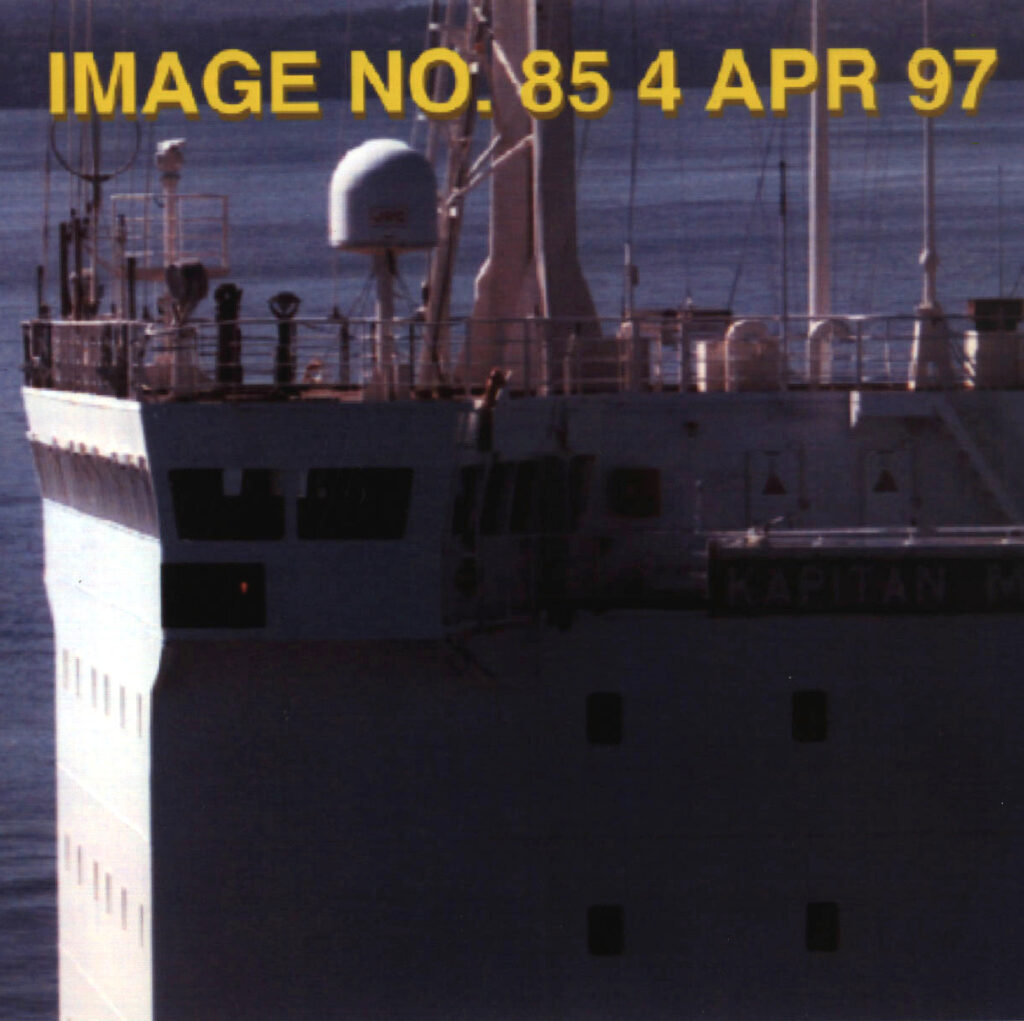
Target Cue
LAEK – JLDS
Kapitan Man / Russian Ship / Puget Sound, WA / April 4, 1997 12:30PM
Subcue: Describe activity around ship and on deck.
Target Background
Allegations have been made that the Kapitan Man (Russian-registry 19,864-dwt ro/ro built in 1985, operated by Far Eastern Shipping Co.), operating in the Strait of Juan de Fuca in Washington, used a laser against a Canadian Air Command CH-124A Sea King on 4 April, 1997. The two aboard, a Canadian Air Command pilot (Capt. Patrick Barnes) and a U.S. Navy officer (Lt. Jack Daly), reportedly suffered eye burns. The two were temporarily blinded at midday eight kilometers/five miles northwest of Port Angeles, Wash. The ship was searched at Tacoma, Wash., by the U.S. Coast Guard on 7 April, on its route between Tacoma, Los Angeles and Vladivostok, Russia. Nothing was found. Protests have been made with the Russian government. Allegations say that the ship was a “spy vessel,” recording the transit of the U.S. Navy’s lead vessel of the U.S.S. Ohio (SSBN 726)-class Nuclear-powered Ballistic Missile Submarine, based at Bangor, Wash. The Kapitan Man has an unusually large number of antennas aboard.
The Kapitan Man
Russian merchant ships owned by Russia’s Far East Shipping Company (FESCO) are according to CIA and NSA reports regularly involved in spying on nuclear submarines based with Submarine Group Nine in Bangor WA. The Kapitan Man had been involved in several incidents prior to April 4, 1997, and had an extensive set of antennae, far exceeding the norm for regular merchant vessels. Previous searches of this particular ship had revealed that the Kapitan Man was equipped with more than a dozen T-7 Sonar buoys, as well as XBT probes used for Anti-Submarine Warfare. The ship is also equipped with a photo processing laboratory. These merchant ships were built in the 1970s for the Soviet Navy as troop and equipment ships, but later bought by FESCO.
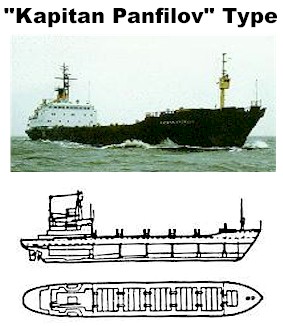
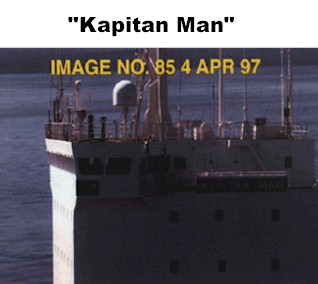
|
Russian Register class |
KM * L1 I A2 |
|
Register gross tonnage |
9965 |
|
tonnage net tonnage |
4903 |
|
Year of construction |
1975 – 1981 |
|
Length overall |
146.21m |
|
Breadth moulded |
20.65m |
|
Depth moulded |
12.9m |
|
Mean ligth draught |
5.91m |
|
Mean load draught |
9.43m |
|
Light displacement |
5533t |
|
Displacement fully laden |
20165t |
|
Deadweight |
14632t |
|
Carrying capacity |
13742t |
|
Number of tons per 1cm of draught |
20.5t |
|
Range of sailing |
6000/10000 miles |
|
Speed |
12.0 knots |
|
Power |
5025Kw |
|
Bunkers |
1030t |
|
Fuel Grade | |
|
Residual fuel |
150 cSt at 50 grad C |
|
Marine distillate fuel |
Gas Oil |
|
Fuel consumption per day | |
|
At sea |
15.0t |
|
At port |
2.2t |
|
Bilge water Separator |
CK-10 1×10 t/h |
|
Mast height from the main deck |
28m |
Viewer Data on “The Kapitan Man”
This is how Jason describes the ship he saw at the target location and correctly labels location in S2 Phonics when he writes “Navy, Pacific”. (Read more in Jason’s post-session interview.)

During the monitored stage of the session, Jason sees the following on the ship deck: “railings, multiple tiers, poles on top, metal, large, people on deck, wearing uniforms, doing their job, naval ship, tanned uniforms, one person is pointing something up from ship deck, holding it up, something making a noise, wearing gloves, chains on deck, middle of ship, on top something pointing up, cylinder-shaped, 3 or 4 cylinders”
He also describes the following while executing the monitored stage of the protocols in a low-Alpha, high-Theta stage: “Large ship, people on board, whitish colors, tiered, windows, voices, end of ship, water, ripples in ocean, fast, horizon, water, land in distance.”
And when he looks down at target from the perspective of 100 feet above the target, he sees the following: “large ship, white water on sides, military ship, submarine close by, guns or antennas on deck”
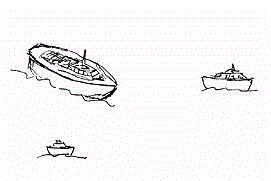
Jason also sees more than one ship, according to reports there were 3 merchant ships entering the strait at the time the helicopter flew overhead to photograph The Kapitan Man.
Sita also saw a ship at the target and labels the water related aspects of target in Cascade as: “Ocean, waves, boat, controller, scientific”.

The Submarine

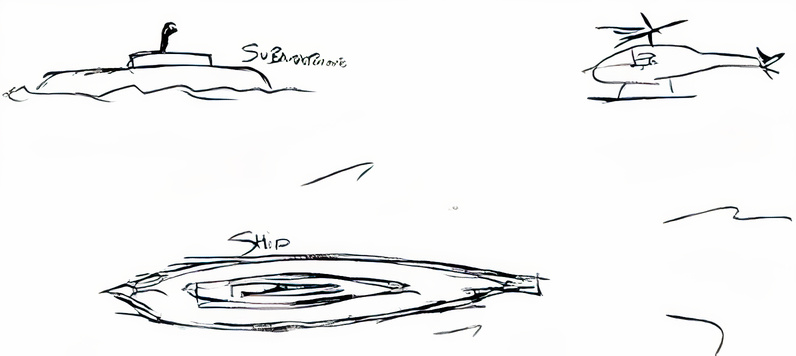
and the submarine.
Ohio Class Ballistic Missile Submarine


- Displacement: 16,500 tons surfaced; 18,500 tons submerged
- Length: 560 feet
- Beam: 42 feet
- Draft: 36 feet
- Propulsion:
- One PWR (Pressurized Water Reactor)
- steam turbines
- single shaft
- Maximum Speed: 25+ knots
- Maximum Depth: 800+ feet
- Crew: 160
- Weapons:
- 24 Trident C-4 or Trident D-5 Ballistic Missiles
- 4 midships 21″ torpedo tubes firing Mk 48 torpedos
Inside The Submarine
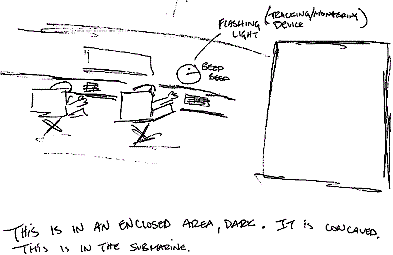
Jason during his low-Alpha, high-Theta stage focuses his awareness on the inside of the submarine he previously described and sees the following: “Enclosed area, some sitting, computers, electronics, dark, dark cylinder, monitoring, lots of electronic beeping sounds, military, naval, tracking, monitoring round screen, like radar but makes beeping sound, concaved, this is in the submarine…”
The Helicopter
A majority of the viewers perceived a helicopter associated with the target. The actual helicopter that was used by Capt. Barnes and Lt. Daly was a Canadian Air Command CH-124A Sea King.
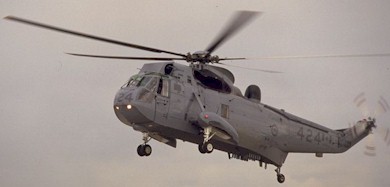
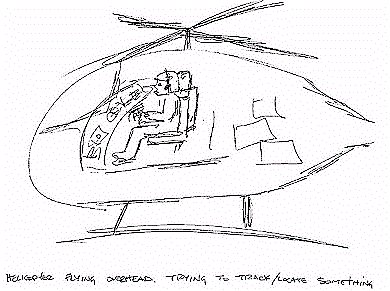
This is what Jason perceived during his monitored stage: “Helicopter flying overhead trying to track / locate something, over ocean, dark color with white letters, couple of people inside”
Banshee also described a helicopter associated with this target. She writes: “Aspect concerns helicopter” and she draws the following.
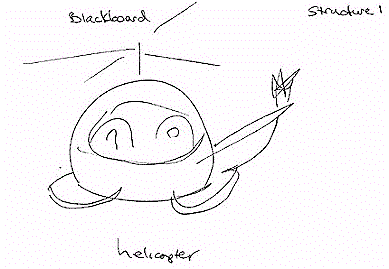
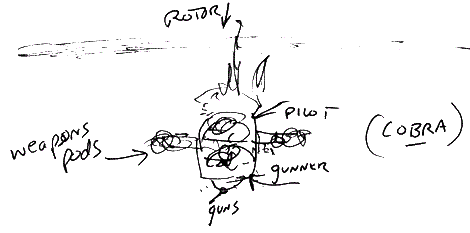
Inside The Helicopter
This is how Banshee describes one of the structures at the target: “Helicopter, military, Navy, 3 on board, loud radio communication, mission incomplete, failed, sudden jerk, sudden change in motion, does not return, record keeper, attempt to survey”
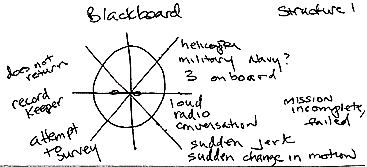
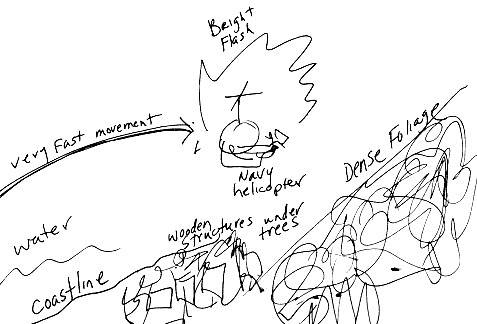
This next excerpt, from Banshee’s S6 diarization notes, is dissected from the original for clarity. The original sheet can be seen under the complete session area. She describes something emanating from the water-level below, causing a “bright flash” in front of the helicopter she labels “Navy helicopter”
Inside the helicopter, Banshee sees primarily two men up front, she labels one as the “pilot” and the other as “Lt. Colonel”. During monitoring, she describes the purpose of this flight as: “Mission, seek, search, military, envelope was sealed, classified data, letter ‘M'”
Jason described the purpose of the flight as: “wants to land, tall antennas, looking for antennas, poles”.
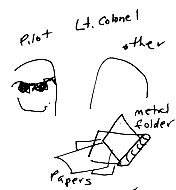
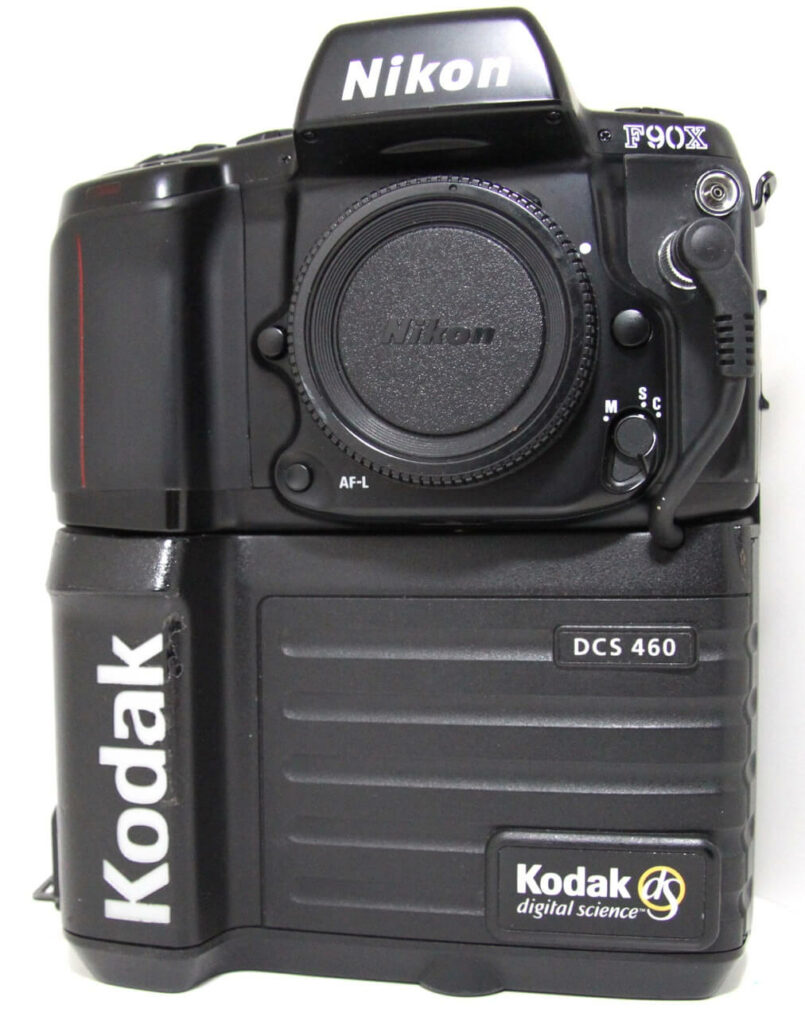

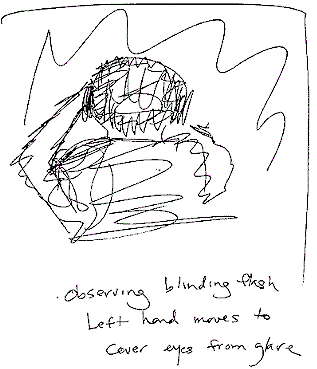
Banshee also perceives the following event inside the helicopter: “Observing blinding flash, left hand moves to cover eyes from glare”. She also describes the energy associated with the target as: “Zap, electrified, charged, jolt of lightning, harmful, dynamic big-time, to destroy”
The Laser Device “Range Finder”
This is how Zoltan described a device he saw in his session that he labeled a “Range Finder”: “Eye pieces, high-tech, enhances vision, heads-up display with data on it, like night vision, gives information, magnifies”
He continues to describe what he actually saw when he adjusted his awareness to the vantage point of looking through this device: “Horizon, strange brightness, very bright, clicking sound, mechanical, weapon sighting, sight-in & lock-on, see at night, “Take it out”, sighting system, weapon, flight, helicopter, up and above trees, banking, no fear, performance”
He described the size of this device to be a little bit wider than the head, about one foot across.
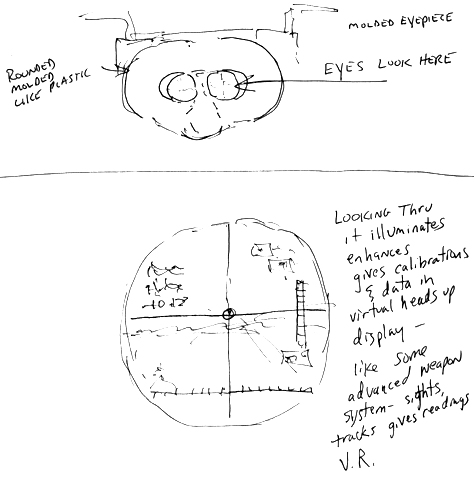
Jason saw the following event take place on the deck of a ship he saw: “one person is pointing something up from ship deck, holding it up” This is an example of a regular commercial Laser Rangefinder Device vs. Zoltan’s description of what he saw:
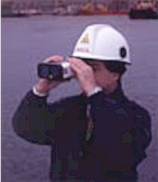
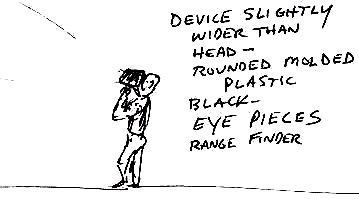
Zoltan also saw a person with something creating “brite, sharp flashes” in his hands.

The Laser Light
One of the viewers (Valtra), described in her work a bright flash of light. This is how she described some of the aspects regarding this light in S2 Phonics: “argon, energy, purple frequency, frequency oscillator“. She went on to Cascade and described the following: “fluctuating wave bands… atom oscillator, photon“. At the stage in the protocols when she examines any human aspects to target, she perceives multiple humans at target, and labels them as following: “foreign language, government related“.
At the monitored stage of the protocols when the viewer is in a low-Alpha, high-Theta state, she relates the following to the monitor regarding the nature of the light as well as its source: “like a bright spotlight flashing, circular, concentric rings with coiled wires, 12 inches wide” and goes on saying: “Coiled filament in concentric arrangement, radiating bright purple light, argon gas / halogen“.
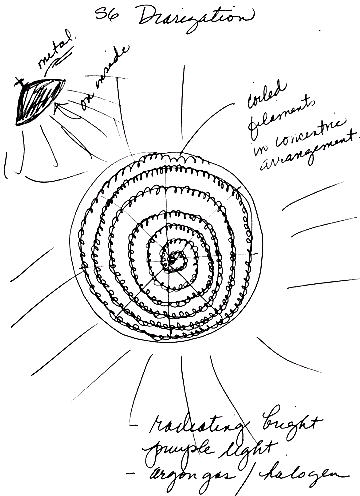
The nature of the laser device that was used in this incident is not known, or has not been made public. Valtra’s data however, suggest that the laser that was used to damage the eyes of Lt. Jack Daly and Capt. Pat Barnes was an Argon based laser system. The following is a brief overview of Argon based laser systems.
The Argon Gas Laser System
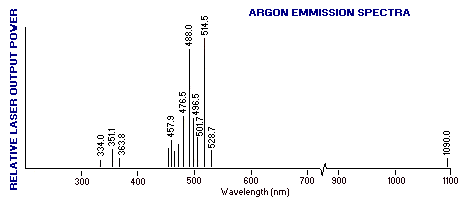
The Argon laser was invented in 1964 by William Bridges at Hughes Aircraft and is one of a family of Ion lasers that use a noble gas as the active medium. This laser is used in many applications such as: Forensic Medicine, Entertainment, General Surgery, Ophthalmic Surgery, Holography, Optical “pumping” source. The argon laser emits a blue-green colored light which is absorbed by hemoglobin in blood cells. When hemoglobin absorbs the laser energy, it is converted to heat. The heat damages and seals the blood vessels, causing them to disintegrate and be reabsorbed into the body.

This image shows all the wavelengths of light emitted by the Argon laser operating in multi-mode. Every wavelength is a monochromatic light source of itself and each wavelength has a very narrow bandwidth. The two dominant wavelengths, of 514nm “Green” and 488nm “Blue” make up about 67% of the total beam output power. Single line operation is also possible by inserting prisms, diffraction gratings and other optical devices to “filter out” the unwanted wavelengths. Of course, when single line operation is required, the total output power decreases dramatically as well.
The laser resonator is made up of two mirrors. One is highly reflective (HR) and other is a partially reflective mirror (OC). From this optic (the Output Coupler) the beam emerges as laser light. The Brewster’s Angle optic mounted at both ends of the tube, minimizes reflection loses while creating a polarized beam. When the laser is first turned on, a delay allows for temperature stabilization. Then a pulse of high voltage (8 kilovolts DC) ionizes the argon gas. Upon ionization, high DC current (45 Amps) and about 600 volts DC across the tube maintains a sufficient discharge to keep the gas ionized. The typical Argon laser tube has a tungsten bore which has a high melting point and allows the laser to operate at higher power levels with longer tube life.
Argon lasers with average powers of over three watts require tap water cooling and separate three phase 220 AC volt @ 50 Amps per phase electrical line feeds.
Safety Note: Argon laser emissions are hazardous to view. Both diffuse and direct exposures beyond the applicable MPE (Maximum Permissible Exposure) limit can cause permanent damage to the retina.
Conclusion
The data collected by the viewers suggest a high degree of target contact, with each viewer focusing in on particular aspects of the target (DOE) . Analysis based on the viewer data suggests the following:
Scenario (Based on data congruency between at least two viewers)
The target is of a military nature. There is at least one ship at the target area. There is a helicopter nearby, possibly involved in searching/surveillance. A dynamic event involving a bright flash of light takes place at the target site.
Analysis
The phenomenon of Division Of Effort (DOE) is especially apparent in this project. The primary point of interest for the tasker of this project was to find out whether the viewers could perceive the activity on the ship deck as well as around the vicinity of The Kapitan Man. However, the helicopter, submarine and alleged laser-device were also high priority aspects. Usually for a target of this complexity, several subcues are required to focus in on various aspects of the target. However, each viewer seemed to focus in on a particular aspect of this target that were on the list of high-priority items from the first session. Thus, upon examination of the viewer data, the tasker determined that subcueing would not be necessary at this point in time. It may be subcued at a future date to extract further data from specific points of interest. Especially regarding complex technological and electronic equipment used at the target site.
Analysis of the viewer data do however suggest the following regarding activity on the deck of The Kapitan Man.
- A “laser-like” device was used at the target site at the time the Canadian helicopter flew over the Kapitan Man.
- It his highly probable that this “laser-like” device was operated by one man on the deck of the Kapitan Man.
- The “laser-like” device is portable, with a size of about one foot across.
Additional Information
Classified Documents Regarding The Kapitan Man Incident >
Official Version Of Incident From The Department of Defense >
Congressional Testimony Of Lt. Jack Daly >
Viewers During Monitored Stage, Post Session Interviews, and Transcripts >
Epilogue
The Kapitan Man Continually Accessing U.S. Ports?
The Kapitan Man on a regular basis is allowed access to U.S. ports as late as May 31, 1999 as this following data indicate:
The schedule of the Trial shipment of Transit Container:
Route: Harbin – Mudadzyan – Suifenhe – Pogranichny – Vladivostok
Commodity: CASTING IRON SPARES ON PALLETS in a 20’ CONTAINER
Shipping Company: FESCO Intermodal
Trucking Company: Primoravtotrans
Dates: April 26th-June 1st, 1999
|
26 April |
The truck with an empty container crossed the Russian Chinese border without any delays in 55 minutes |
|
26 April | The truck arrived to Mudadzyan, the container was then picked up by the Chinese Trucking company, partner of Primoravtotrans and left for Harbin. |
|
28 April |
The container was loaded in Harbin with casting iron spares, the necessary fumigation caused several hours of delay. |
|
29 April |
The container was delivered to Suifenhe and put on a different truck, owned by Primoravtrans. *This was an exception made by the Russian customs for the trial shipment. In the other case the container should enter Russia with the same truck it left the country with. |
|
30 April |
The truck than crossed the border according to the scheme described in the technological scheme |
|
30 April |
The truck has arrived to the Commercial Port of Vladivostok, and was put on the Terminal 62, waiting for the FESCO ship to arrive. |
|
12 May |
Container was loaded on a FESCO ship “Kapitan Man“, following the route: Vladivostok – Busan – Petropavlovsk – Kamchatsky – Seattle |
|
31 May |
Arrival of “Kapitan Man” to Seattle |
|
(Information gathered with the help of FESCO Intermodal, Primoravtotrans, Commercial Port of Vladivostok, Primorsky Kray Administration and Washington State Trade Office in Vladivostok.) | |
However, the arrival of The Kapitan Man is always unreported, as the following data from The National Climatic Data Center indicates:
Ships Not Reporting (1998) (Source: The National Climatic Data Center) – Sorted by Ship Name
|
Ship Name |
Call |
Port |
Jan |
Feb |
Mar |
Apr |
May |
Jun |
Jul |
Aug |
Sep |
Oct |
Nov |
Dec |
Tot |
|
KAPITAN GNEZPILOV |
UQMF |
Seattle |
0 |
0 |
0 |
0 |
0 |
0 |
0 |
0 |
0 |
0 |
0 |
0 |
0 |
|
KAPITAN MAN |
UJCQ |
Seattle |
0 |
0 |
0 |
0 |
0 |
0 |
0 |
0 |
0 |
0 |
0 |
0 |
0 |
|
KAPITAN SERYKH |
UGOZ |
Seattle |
0 |
0 |
0 |
0 |
0 |
0 |
0 |
0 |
0 |
0 |
0 |
0 |
0 |
This is where Kapitan Man should be listed if it reported as is the norm among regular merchant vessels. However, it is not.
Ship Count Report (1998) (Source: The National Climatic Data Center) – Sorted by Ship Name
|
Ship Name |
Call |
Port |
Jan |
Feb |
Mar |
Apr |
May |
Jun |
Jul |
Aug |
Sep |
Oct |
Nov |
Dec |
Tot |
|
KAPITAN BYANKIN |
UAGK |
Seattle |
9 |
21 |
26 |
24 |
5 |
0 |
0 |
0 |
0 |
0 |
0 |
0 |
85 |
|
KAPITAN KONEV |
UAHV |
Seattle |
22 |
20 |
41 |
59 |
32 |
56 |
44 |
0 |
0 |
0 |
0 |
0 |
274 |
|
KAPITAN MASLOV |
UBRO |
Seattle |
15 |
9 |
24 |
37 |
46 |
56 |
57 |
0 |
0 |
0 |
0 |
0 |
244 |
|
KAREN ANDRIE |
WBS5272 |
Chicago |
0 |
0 |
2 |
31 |
33 |
29 |
14 |
0 |
0 |
0 |
0 |
0 |
109 |
Fortunately enough steps are finally being taken to ensure the security of the U.S. as can be seen by the following congressional bill, introduced by Congressman Hunter:
Activities of the House Committee on Transportation and Infrastructure
Bud Shuster, Chairman
April 19 – 23, 1999
HR1508 (Hunter)
A bill to prohibit entry of the Russian vessel KAPITAN MAN into any port in the U.S. at which there is a U. S. naval presence; Committee on Intelligence.